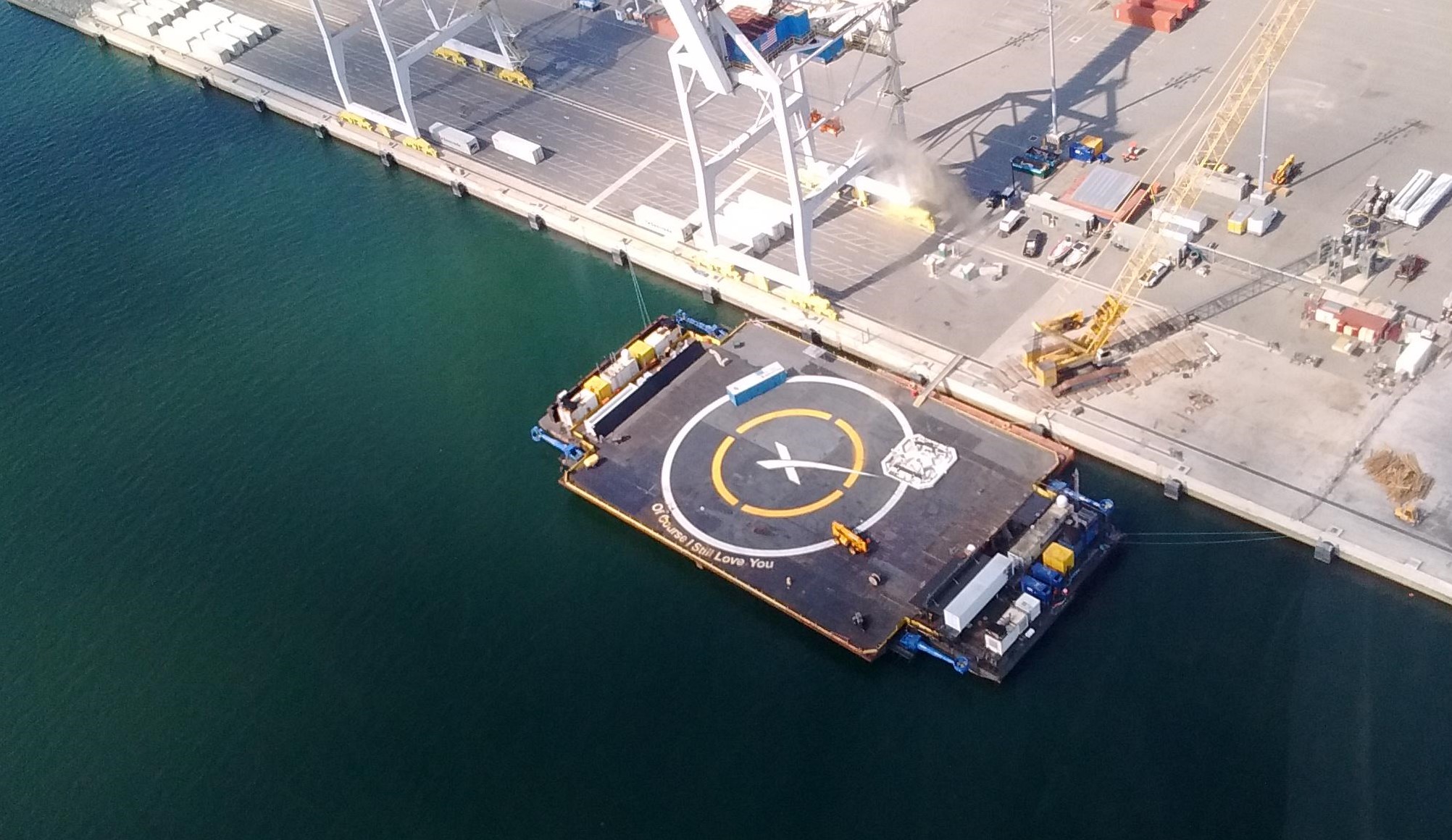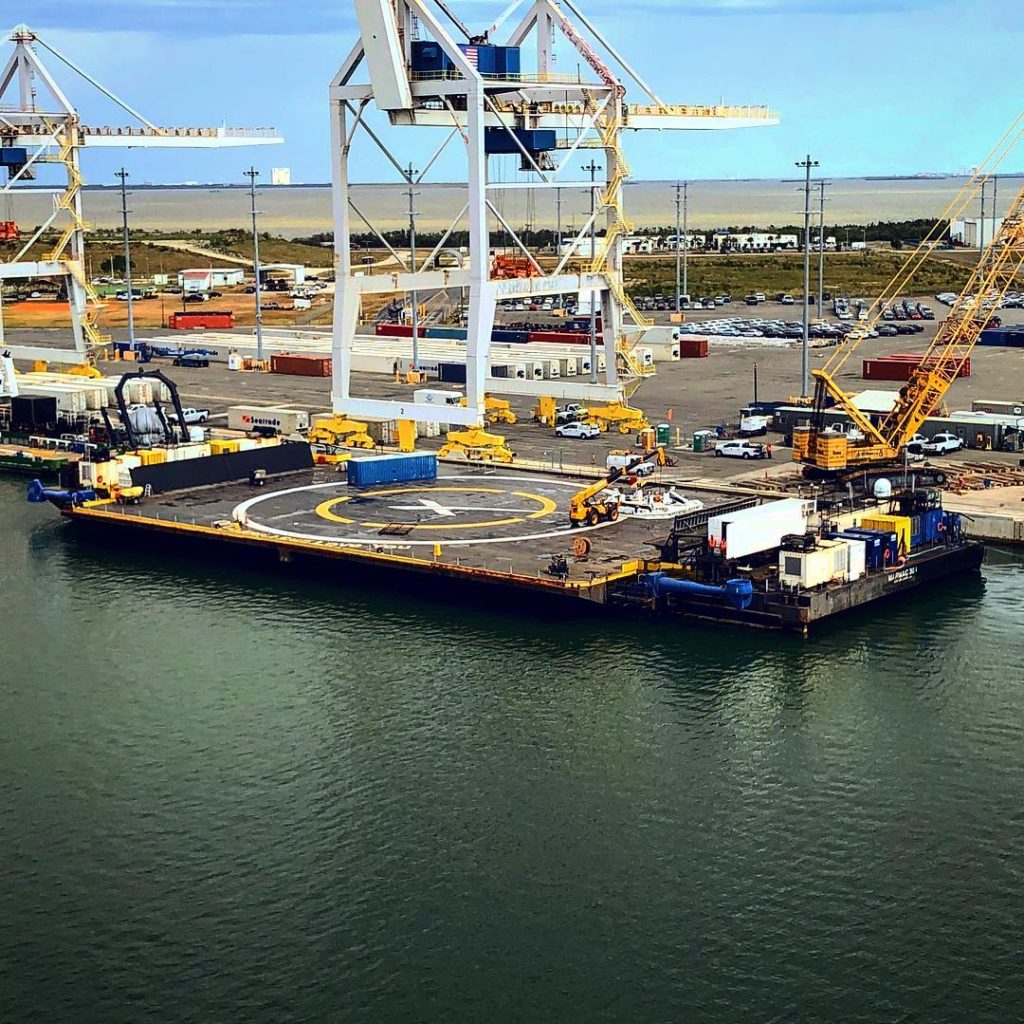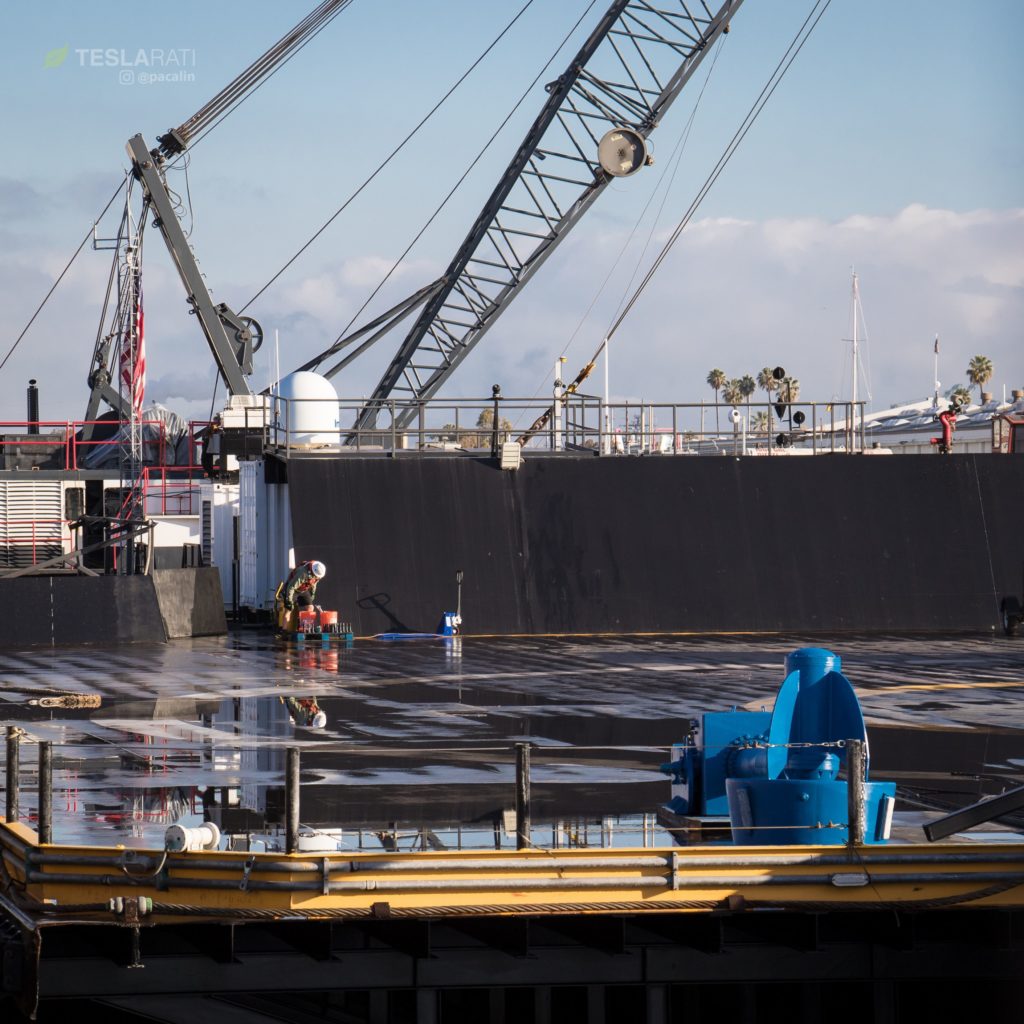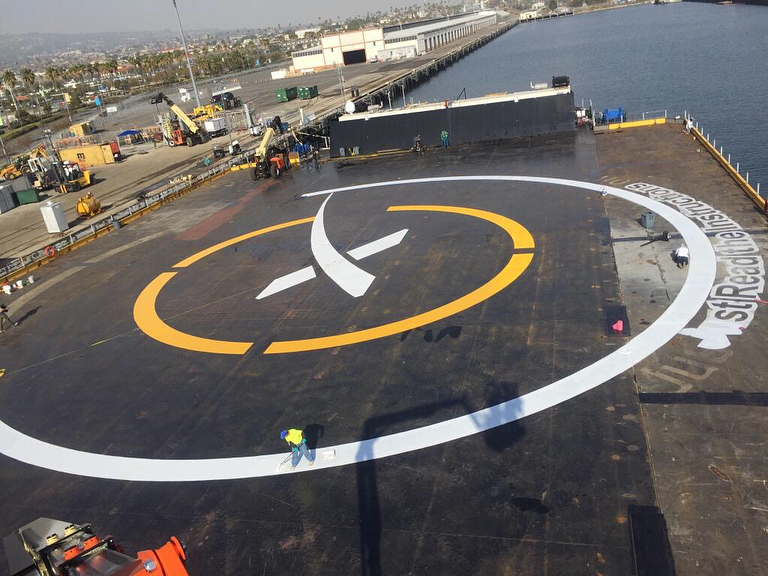

News
SpaceX’s drone ship fleet spied prepping for future rocket recoveries
Just shy of three weeks since SpaceX’s last launch and the better part of half a year since the last successful ocean recovery, both of the company’s drone ships have been spotted in recent weeks being refurbished, refitted, and prepared for a return to the ocean.
The unusual drought of drone ship landings was nearly brought to an end in early March, but that recovery attempt – following the successful launch of Hispasat 30W-6 – was precluded by extreme weather in the landing zone, forcing booster 1044 to soft-land in the Atlantic with a swan call of landing legs and titanium grid fins. Several weeks before 1044’s demise, the inaugural launch of Falcon Heavy also saw the first failed booster recovery attempt since June 2016, ending a successful streak of 17 flawless Falcon 9 recoveries – though both side boosters did manage a spectacular, synchronized landing at LZs 1 and 2.
Before the Falcon Heavy attempt, East coast drone ship Of Course I Still Love You (OCISLY) successfully recovered a Falcon 9 booster for the last time in late October 2017, a handful of weeks after the successful recovery of SES-11 – the source of a small fire that famously destroyed SpaceX’s robotic stage securer, nicknamed Roomba or Octagrabber. Over the several months, since it was damaged, Octagrabber has gradually undergone refurbishment at SpaceX’s Port Canaveral berth, most recently appearing back on OCISLY for post-refurb testing.
With the introduction of Falcon 9 Block 5 presumably a month or less away, the days of expending once flight-proven boosters will almost certainly be over, aside from missions that truly require the booster’s full performance. As discussed yesterday, regardless of whether Block 5 is truly ready for the limelight, SpaceX is no more than two months away from effectively running out of all older boosters: the once-flown B1045 (TESS) will likely be the only flight-worthy heritage booster remaining by early May. In other words, every single SpaceX launch in the second half of 2018 is all but guaranteed to attempt recovery, either by land or sea.
- OCISLY as seen by Tom Cross on March 5, readying for a busy future of rocket recoveries. (Tom Cross)
- Roomba was spied aboard OCISLY for the first time in months earlier this month. (Instagram /u/grimlok77)
OCISLY is effectively prepared to support these upcoming recovery attempts, and its Octagrabber may be as well. However, OCISLY was reportedly damaged by Falcon Heavy’s center core, despite the fact that it quite visibly missed the drone ship. Presumably, the forlorn booster acted as a sort of depth charge, thus damaging beyond repair the drone ship’s sensitive maneuvering and station-keeping thrusters. Before Falcon Heavy, it’s likely that the same fire that burned Octagrabber also damaged the hydraulic systems of one or several of OCISLY’s thrusters. These conclusions are supported by the fact that SpaceX’s West coast drone ship, Just Read The Instructions (JRTI), has visibly been stripped of its functional thrusters, presumably used to keep OCISLY operational in anticipation of Falcon Heavy and later Hispasat 30W-6.
Mr Steven, SpaceX’s only current fairing recovery vessel, has also been spotted conducting some sort of sea trials just off the shore of Port of San Pedro and LA, presumably honing recovery operations and giving its pilots time to practice catching fairings. Following the launch of PAZ and SpaceX’s own prototype Starlink satellites, the company managed its first-ever intact fairing recovery, although it missed Mr Steven’s net by a few hundred feet. As stated by Musk, it should be relatively easy to go from missing by a few hundred feet to successfully catching the fairing, and it’s likely that the imminent launch of Iridium-5 (7:19 am PDT, March 29) will attempt to close that gap and actually catch a fairing halve. On the other hand, the booster – flight-proven during the October 2017 launch of Iridium-3 – will likely soft-land in the Pacific Ocean because JRTI is currently unable to support ocean recoveries, lacking two of its four thrusters.
- Teslarati photographer Pauline Acalin took a trip down to Port of San Pedro to check up on JRTI, March 25. (Pauline Acalin)
- Note one of JRTI’s thrusters here, quite clearly not installed. A second one sits just out of sight on the right. (Pauline Acalin)
- SpaceX’s West coast drone ship Just Read The Instructions getting some much needed fresh paint. (Instagram, anonymous)
Follow us for live updates, behind-the-scenes sneak peeks, and a sea of beautiful photos from our East and West coast photographers.
Teslarati – Instagram – Twitter
Tom Cross – Twitter
Pauline Acalin – Twitter
Eric Ralph – Twitter

Elon Musk
Elon Musk’s X will start using a Tesla-like software update strategy
The initiative seems designed to accelerate updates to the social media platform, while maintaining maximum transparency.

Elon Musk’s social media platform X will adopt a Tesla-esque approach to software updates for its algorithm.
The initiative seems designed to accelerate updates to the social media platform, while maintaining maximum transparency.
X’s updates to its updates
As per Musk in a post on X, the social media company will be making a new algorithm to determine what organic and advertising posts are recommended to users. These updates would then be repeated every four weeks.
“We will make the new 𝕏 algorithm, including all code used to determine what organic and advertising posts are recommended to users, open source in 7 days. This will be repeated every 4 weeks, with comprehensive developer notes, to help you understand what changed,” Musk wrote in his post.
The initiative somewhat mirrors Tesla’s over-the-air update model, where vehicle software is regularly refined and pushed to users with detailed release notes. This should allow users to better understand the details of X’s every update and foster a healthy feedback loop for the social media platform.
xAI and X
X, formerly Twitter, has been acquired by Elon Musk’s artificial intelligence startup, xAI last year. Since then, xAI has seen a rapid rise in valuation. Following the company’s the company’s upsized $20 billion Series E funding round, estimates now suggest that xAI is worth tens about $230 to $235 billion. That’s several times larger than Tesla when Elon Musk received his controversial 2018 CEO Performance Award.
As per xAI, the Series E funding round attracted a diverse group of investors, including Valor Equity Partners, Stepstone Group, Fidelity Management & Research Company, Qatar Investment Authority, MGX, and Baron Capital Group, among others. Strategic partners NVIDIA and Cisco Investments also continued support for building the world’s largest GPU clusters.
News
Tesla FSD Supervised wins MotorTrend’s Best Driver Assistance Award
The decision marks a notable reversal for the publication from prior years, with judges citing major real-world improvements that pushed Tesla’s latest FSD software ahead of every competing ADAS system.

Tesla’s Full Self-Driving (Supervised) system has been named the best driver-assistance technology on the market, earning top honors at the 2026 MotorTrend Best Tech Awards.
The decision marks a notable reversal for the publication from prior years, with judges citing major real-world improvements that pushed Tesla’s latest FSD software ahead of every competing ADAS system. And it wasn’t even close.
MotorTrend reverses course
MotorTrend awarded Tesla FSD (Supervised) its 2026 Best Tech Driver Assistance title after extensive testing of the latest v14 software. The publication acknowledged that it had previously criticized earlier versions of FSD for erratic behavior and near-miss incidents, ultimately favoring rivals such as GM’s Super Cruise in earlier evaluations.
According to MotorTrend, the newest iteration of FSD resolved many of those shortcomings. Testers said v14 showed far smoother behavior in complex urban scenarios, including unprotected left turns, traffic circles, emergency vehicles, and dense city streets. While the system still requires constant driver supervision, judges concluded that no other advanced driver-assistance system currently matches its breadth of capability.
Unlike rival systems that rely on combinations of cameras, radar, lidar, and mapped highways, Tesla’s FSD operates using a camera-only approach and is capable of driving on city streets, rural roads, and freeways. MotorTrend stated that pure utility, the ability to handle nearly all road types, ultimately separated FSD from competitors like Ford BlueCruise, GM Super Cruise, and BMW’s Highway Assistant.
High cost and high capability
MotorTrend also addressed FSD’s pricing, which remains significantly higher than rival systems. Tesla currently charges $8,000 for a one-time purchase or $99 per month for a subscription, compared with far lower upfront and subscription costs from other automakers. The publication noted that the premium is justified given FSD’s unmatched scope and continuous software evolution.
Safety remained a central focus of the evaluation. While testers reported collision-free operation over thousands of miles, they noted ongoing concerns around FSD’s configurable driving modes, including options that allow aggressive driving and speeds beyond posted limits. MotorTrend emphasized that, like all Level 2 systems, FSD still depends on a fully attentive human driver at all times.
Despite those caveats, the publication concluded that Tesla’s rapid software progress fundamentally reshaped the competitive landscape. For drivers seeking the most capable hands-on driver-assistance system available today, MotorTrend concluded Tesla FSD (Supervised) now stands alone at the top.
News
Elon Musk’s Grokipedia surges to 5.6M articles, almost 79% of English Wikipedia
The explosive growth marks a major milestone for the AI-powered online encyclopedia, which was launched by Elon Musk’s xAI just months ago.

Elon Musk’s Grokipedia has grown to an impressive 5,615,201 articles as of today, closing in on 79% of the English Wikipedia’s current total of 7,119,376 articles.
The explosive growth marks a major milestone for the AI-powered online encyclopedia, which was launched by Elon Musk’s xAI just months ago. Needless to say, it would only be a matter of time before Grokipedia exceeds English Wikipedia in sheer volume.
Grokipedia’s rapid growth
xAI’s vision for Grokipedia emphasizes neutrality, while Grok’s reasoning capabilities allow for fast drafting and fact-checking. When Elon Musk announced the initiative in late September 2025, he noted that Grokipedia would be an improvement to Wikipedia because it would be designed to avoid bias.
At the time, Musk noted that Grokipedia “is a necessary step towards the xAI goal of understanding the Universe.”
Grokipedia was launched in late October, and while xAI was careful to list it only as Version 0.1 at the time, the online encyclopedia immediately earned praise. Wikipedia co-founder Larry Sanger highlighted the project’s innovative approach, noting how it leverages AI to fill knowledge gaps and enable rapid updates. Netizens also observed how Grokipedia tends to present articles in a more objective manner compared to Wikipedia, which is edited by humans.
Elon Musk’s ambitious plans
With 5,615,201 total articles, Grokipedia has now grown to almost 79% of English Wikipedia’s article base. This is incredibly quick, though Grokipedia remains text-only for now. xAI, for its part, has now updated the online encyclopedia’s iteration to v0.2.
Elon Musk has shared bold ideas for Grokipedia, including sending a record of the entire knowledge base to space as part of xAI’s mission to preserve and expand human understanding. At some point, Musk stated that Grokipedia will be renamed to Encyclopedia Galactica, and it will be sent to the cosmos.
“When Grokipedia is good enough (long way to go), we will change the name to Encyclopedia Galactica. It will be an open source distillation of all knowledge, including audio, images and video. Join xAI to help build the sci-fi version of the Library of Alexandria!” Musk wrote, adding in a later post that “Copies will be etched in stone and sent to the Moon, Mars and beyond. This time, it will not be lost.”













